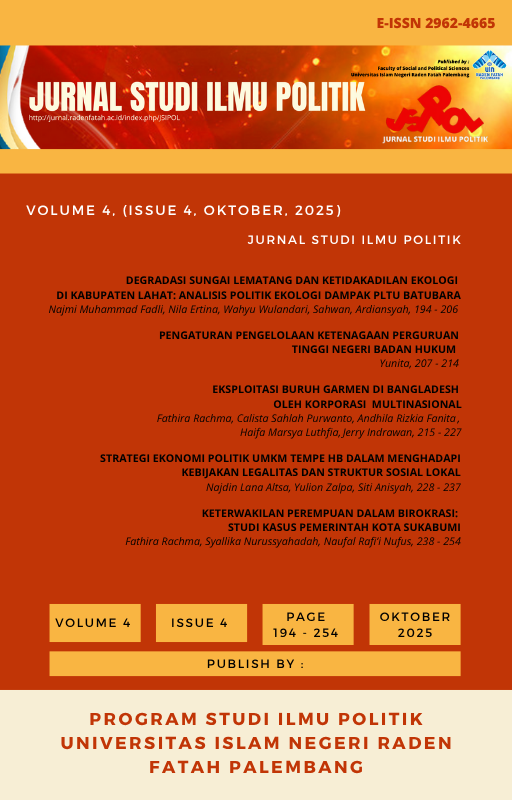Degradasi Sungai Lematang Dan Ketidakadilan Ekologi Di Kabupaten Lahat: Analisis Politik Ekologi Dampak Pltu Batubara
Main Article Content
Abstract
Lahat Regency exemplifies the paradox of extractive development in Indonesia, where the expansion of coal mining and the operation of the Keban Agung coal-fired power plant (2×135 MW)—often promoted as drivers of regional economic growth—have instead produced systematic ecological degradation of the Lematang River. This study employs a mixed-methods approach, combining laboratory testing, field observation, and in-depth interviews, to examine the link between industrial activities and water quality deterioration. The findings reveal severe acidification in the Pole River (pH 4.33–4.48), posing a direct threat to the Lematang River, the primary water source for 5,892 residents in three affected villages. The declining pH gradient from upstream to downstream indicates continuous acid loading originating from Fly Ash and Bottom Ash (FABA) discharge of the power plant. Documented socio-ecological impacts include a 60–70% decline in agricultural yields, a 50–60% reduction in fish catch, and a decrease in the Water Quality Index (WQI) from 85.7 (2021) to 76.8 (2024). Using the framework of political ecology, this research demonstrates how local communities have become “sacrifice zones”, bearing the negative externalities of extractive operations without equitable benefit sharing. The study identifies regulatory capture and state failure as structural mechanisms that perpetuate environmental injustice and asymmetric power relations. Conceptually, this work contributes to the literature on extractive industries and water commons degradation, while empirically providing a foundation for policy reform and environmental justice advocacy in Indonesia’s coal-producing regions.
Downloads
Article Details

This work is licensed under a Creative Commons Attribution-ShareAlike 4.0 International License.
Authors who publish with this journal agree to the following terms:
- Authors retain copyright and grant the journal right of first publication with the work simultaneously licensed under a Creative Commons Attribution License that allows others to share the work with an acknowledgement of the work's authorship and initial publication in this journal.
- Authors are able to enter into separate, additional contractual arrangements for the non-exclusive distribution of the journal's published version of the work (e.g., post it to an institutional repository or publish it in a book), with an acknowledgement of its initial publication in this journal.
- Authors are permitted and encouraged to post their work online (e.g., in institutional repositories or on their website) prior to and during the submission process, as it can lead to productive exchanges, as well as earlier and greater citation of published work
How to Cite
References
Agrawal, A., & Gibson, C. C. (1999). Enchantment and disenchantment: The role of community in natural resource conservation. World Development, 27(4), 629-649.
Auty, R. M. (2001). Resource abundance and economic development. Oxford: Oxford University Press.
Ayres, I., & Braithwaite, J. (1992). Responsive regulation: Transcending the deregulation debate. Oxford: Oxford University Press.
Badan Pusat Statistik Lahat. (2024). Kabupaten Lahat dalam Angka 2024. Lahat: BPS Kabupaten Lahat.
Baker, J. P., & Schofield, C. L. (1982). Aluminum toxicity to fish in acidic waters. Water, Air, and Soil Pollution, 18(1), 289-309.
Berkes, F. (2012). Sacred ecology (3rd ed.). New York: Routledge.
Bryant, R. L., & Bailey, S. (1997). Third world political ecology. London: Routledge.
Bullard, R. D. (1990). Dumping in Dixie: Race, class, and environmental quality. Boulder: Westview Press.
Chapra, S. C. (2008). Surface water-quality modeling. Long Grove, IL: Waveland Press.
Creswell, J. W., & Plano Clark, V. L. (2017). Designing and conducting mixed methods research (3rd ed.). Thousand Oaks: SAGE Publications.
Driscoll, C. T., Lawrence, G. B., Bulger, A. J., Butler, T. J., Cronan, C. S., Eagar, C., et al. (2001). Acidic deposition in the northeastern United States. BioScience, 51(3), 180-198.
Irwin, A. (1995). Citizen science: A study of people, expertise and sustainable development. London: Routledge.
Johnson, D. B., & Hallberg, K. B. (2005). Acid mine drainage remediation options: A review. Science of the Total Environment, 338(1-2), 3-14.
Keputusan Menteri Negara Lingkungan Hidup Nomor 115 Tahun 2003 tentang Pedoman Penentuan Status Mutu Air.
Laboratorium Kimia Analisa dan Instrumentasi Pengujian FMIPA Universitas Sriwijaya. (2025). Laporan hasil pengujian yang disederhanakan No.188-LHU-2025-LKAIP-FMIPA. Inderalaya: LKAIP FMIPA Unsri.
Lerner, S. (2010). Sacrifice zones: The front lines of toxic chemical exposure in the United States. Cambridge, MA: MIT Press.
Margono, B. A., Turubanova, S., Zhuravleva, I., Potapov, P., Tyukavina, A., Baccini, A., et al. (2012). Mapping and monitoring deforestation and forest degradation in Sumatra (Indonesia) using Landsat time series data sets from 1990 to 2010. Environmental Research Letters, 7(3), 034010.
Martinez-Alier, J. (2002). The environmentalism of the poor: A study of ecological conflicts and valuation. Cheltenham: Edward Elgar.
Mattigod, S. V., Rai, D., Eary, L. E., & Ainsworth, C. C. (1990). Geochemical factors controlling the mobilization of inorganic constituents from fossil fuel combustion residues. Journal of Environmental Quality, 19(2), 188-201.
McCarthy, J. F., & Cramb, R. A. (2009). Policy narratives, landholder engagement, and oil palm expansion on the Malaysian and Indonesian frontiers. The Geographical Journal, 175(2), 112-123.
McDonald, D. G., Reader, J. P., & Dalziel, T. R. (1989). The combined effects of pH and trace metals on fish ionoregulation. In R. Morris et al. (Eds.), Acid toxicity and aquatic animals (pp. 221-242). Cambridge: Cambridge University Press.
Ostrom, E. (1990). Governing the commons: The evolution of institutions for collective action. Cambridge: Cambridge University Press.

